Hello and welcome to ‘Focused on Feld’. In this series of reviews, I am working my way backwards through Stefan Feld’s entire catalogue. Over the years, I have hunted down and collected every title he has ever put out. Needless to say, I’m a fan of his work. I’m such a fan, in fact, that when I noticed that there were no active Stefan Feld fan groups active on Facebook, I created one of my own.
Today we’re going to talk about 2013’s Bora Bora, his 16th game.
Bora Bora is an island group located in French Polynesia. To give you a better idea of where that is, just draw a line going south from Hawaii and another line going west from Peru. Those two lines will intersect in the general vicinity of the islands.
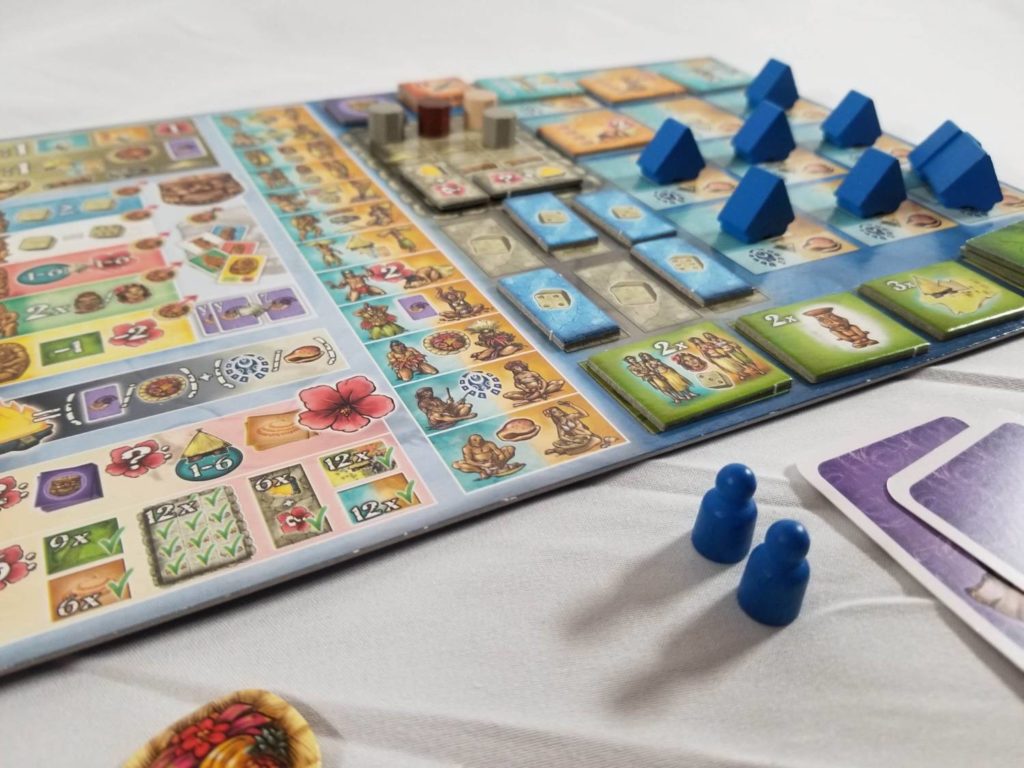
The island group was first inhabited in the 3rd century AD, but wouldn’t become known to the rest of the world until some 1,300 years later when Magellan spotted the island in 1521 during one of his expeditions. Within 200 years, European visitors went from being an anomaly to being the norm. And, as these things go, it didn’t take much longer before the Europeans began pushing the natives aside and laying claim to the land for themselves.
It’s a testament to how far we’ve come as a society that this theme, one that nobody batted an eye at less than ten years ago, is now seen as very troublesome. Thomas Wells talks about this in-depth in his article, What Are We Playing At? While Bora Bora doesn’t actively celebrate the colonialism that played a large part in its inspiration becoming the tourist destination that it is today, it’s never mentioned at all, and that’s almost just as bad. Perhaps that’s one of the reasons that Stefan Feld selected it as one of the games slated for the Stefan Feld City Collection treatment. Slated for crowdfunding in 2023, Bora Bora has been reimagined and redesigned as Cuzco. But, perhaps that wasn’t a consideration since Cuzco was the capital of the Incan empire. And, if you know your history, you know how that went.
Overview
In Bora Bora, you are controlling a tribe of people that live on the titular islands. Each round, players roll and place their dice to perform the various actions which will increase their holdings and earn them victory points. Each die placed on one of the actions must be lower than the lowest die currently on the action. After six rounds, the game comes to an end and the player with the highest victory point total wins.
Of course this is a very high level overview of the game. If you’d like to learn how Bora Bora is played, just click the button below.
Setup
A game of Bora Bora is set up thusly:
Each player chooses a color and receives the Player board and pieces of their chosen color. In addition, each player is given two randomly drawn cards from the God cards deck, a set of Building tiles, two randomly drawn Dark Green task tiles, a randomly drawn light green Task tile, two Offerings tiles, a God tile, and a randomly drawn Turn Order tile. The Building tiles are placed onto the marked spots on the Player boards, as are the Task tiles and the player’s huts. The remaining Task tiles are shuffled together and placed face down next to the game board.
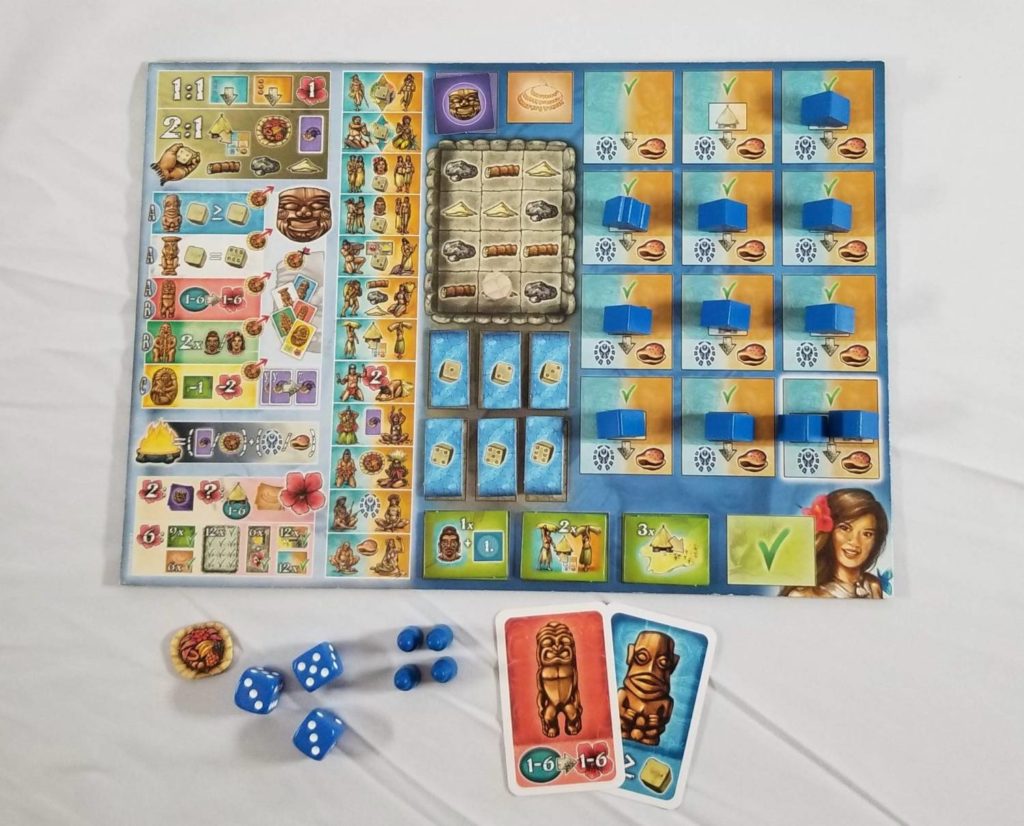
Next is the game board, which is divided into several islands on the left side of the board and an area with tracks and storage for round-specific tiles on the right. Randomly place the Fish tiles, all 24 jewelry tiles, and the starting Task tiles into the spaces provided. Next, shuffle the Man tiles and the Woman tiles into separate piles and place them face down next to the game board. Six of each are drawn and placed face up into the appropriate spaces on the game board.
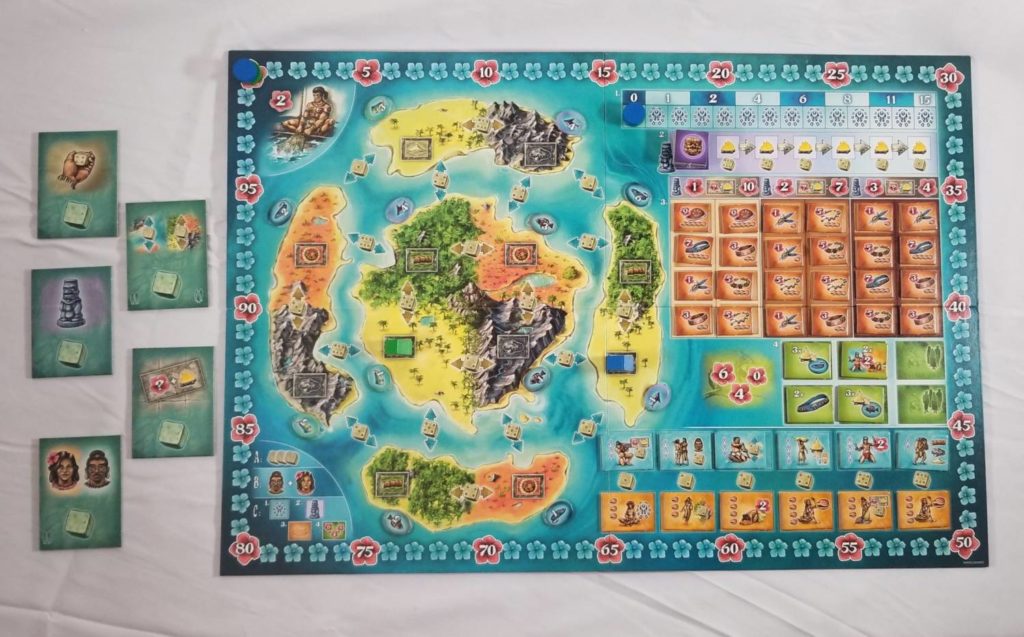
The Turn order tiles show each person’s position in the turn order. Load up the Scoring and Status tracks accordingly. Then, going in reverse order, each player will place one of their huts on a building space on one of the island spaces that has a ‘1’ fish tile next to it and then collect one of whichever resource that area of the island produces.
Once all of this has been completed, you are finally ready to begin playing.
Phases and Turn Sequence
Bora Bora is played in a series of six turns, each consisting of three separate and distinct phases: rolling and placing dice, using Man and Woman tiles, and assessing the right side of the board. After the sixth turn is completed, each player’s scores are tallied and the person with the highest score wins.
Phase A: Rolling and Placing Dice
Each player rolls their three dice. The first player will place one of their dice onto one of the Action cards and take the depicted action. The second player places theirs, then the third, so on and so forth until every player has placed all their dice and taken all their actions. There is one caveat, though, and this is where the strategic aspect of this game begins to shine through. You may only place a die on a card that already has another die on it as long as the number on your die is less than the number on the die that is already there. This means that if you were first and placed a die numbered 1 on the ‘building’ Action card, nobody else could take that action unless they used the proper God card to cheat (more on this later). The Action cards to choose from will vary from game to game depending on how many people are playing, but they will all fall into one of these categories: build something; acquire a Man or Woman tile; expand; place a priest into the temple; use the helper action; or go fishing.
Build something: Use resources to build Building tiles, earning points in the process. The act of building is worth a lot of points early in the game but becomes less lucrative in later turns. If you’ve ever played The Castles of Burgundy, this will no doubt seem familiar.
In addition to moving up the scoring track, the player who has built something also receives the ‘fire bonus’. The fire bonus allows the player to either draw a God card or add an Offerings tile to their supply AND to either move up the status track or add a shell tile to their supply.

Expanding: Use the expansion Action card to place huts from your player board to the game board, earning the depicted resources, and kick out another player’s hut from the building spot and replace it with your own if there’s already a hut there. Each person may only have a single hut in any given region. Whoever has their hut in a building spot at the end of the game will earn points equal to the number on the fish tile that is next to the building spot.
The Helper Action: There are two categories of helper actions: those that can be traded at a 1:1 ratio and those that can be traded at a 2:1 ratio.
In the 1:1 column, your options are: Move a Man down to tattoo him (increase your position on the status tracker); Move a Woman down to collect shells (add shell tiles to your supply); Trade die pips for victory points.
In the 2:1 column, your options are to trade die pips: for resources, to move huts into the #12 spot on your player mat (it can hold any number of huts), to pick up Offerings tiles, or to draw a God card and add it to your hand.

Acquiring Men and Women Tiles: In order to acquire one of these tiles, you must have an empty spot for them on your player mat. Each of the huts on your player mat occupies a space where a Man or a Woman could potentially be. Expanding to the islands or moving your huts to the #12 spot are the only ways that you can make room for Men or Women on your player mat.
Each Man and each Woman is slightly different (but most of them have twins). The icons on the left of these tiles represent the Man or Woman’s ‘use once’ action. When you add a Man or Woman to your player mat, they are placed above the green check mark. Using the helper action allows you to move them down, so that the green check mark is revealed, to use their ‘use once’ action to add shells to your supply or increase your status on the status tracker. The effects on the right side of the tiles do not come into play until Phase B.
Placing Priests in the Temple: Place a Priest into the temple, displacing any priests that need to be displaced. If this displacement should cause a priest to fall off, it is returned to its owner. Then take the ‘fire bonus’.
Having priests in the temple at the end of the turn will garner you victory points per each priest that you have in the temple.
Going Fishing: If you are ever in a position where you cannot place a die on one of the action cards, then you may take the Fishing action instead, which will earn you two victory points.
Once every player has placed all of their dice and taken all of their actions, then Phase B begins.
Phase B: Using Man and Woman Actions
During this phase, you may use exactly one Man and exactly one Woman to perform the actions on the right side of their tiles. It does not matter if that Man or Woman has been moved down. The actions vary, but I will list a few just to give you an idea:
– Acquire a Man or a Woman tile costing three or less from the Men and Women that remain
– Build a building that costs three or less
– Gather one of any resource
– Move up one on the status track
– Travel over land or sea by a route that costs 3 or less
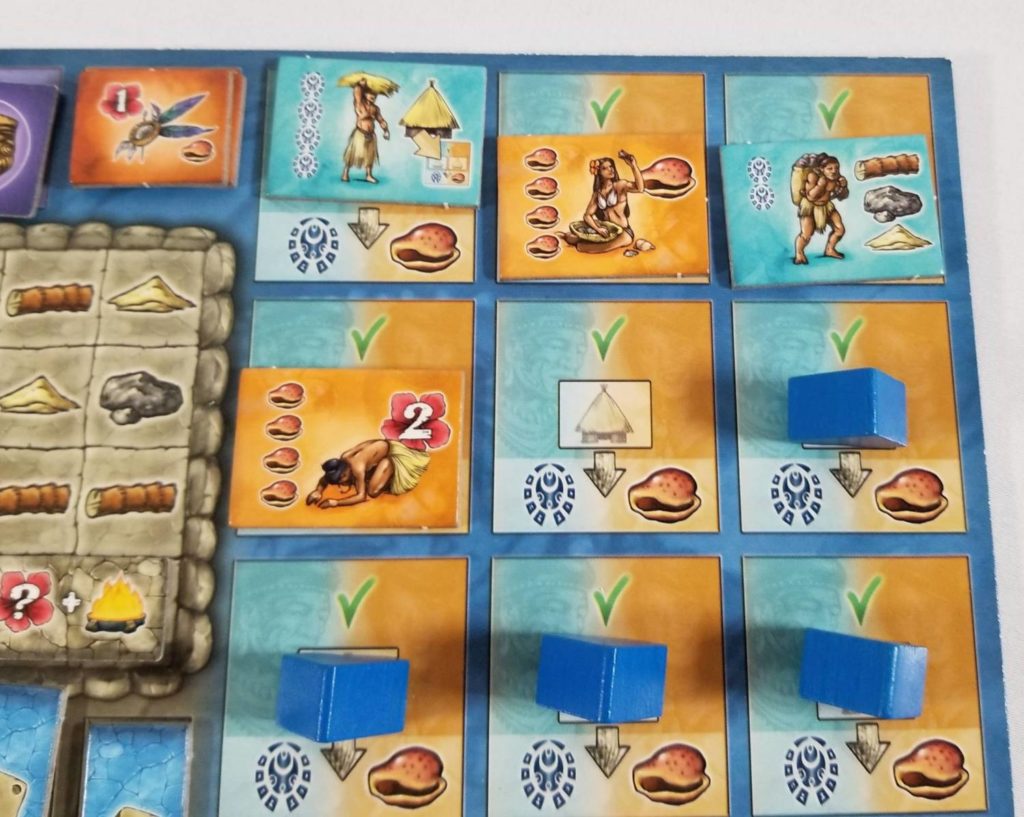
If you happen to have a Man or a Woman that are exactly the same, then the power of their effect is doubled. Let’s say that you have a Woman who you can use to get a free shell tile and you have her twin. You can use just one of them, but the effect is compounded. You will receive two shells instead. Likewise, if you have a Man that lets you take another Man onto your player board that costs 3 or less and you have his twin, you can now choose from the Men on the game board that are 6 and less (3 times 2).
Once every player has taken their Man and Woman actions, then Phase C begins.
Phase C: Assess the Right Side of the Board
The right side of the game board is assessed from the top down. From the top:
The Status Track: The status track is broken up into small segments that are each labeled with the tattoo icon. For every tattoo (status) that you gain during a round, you will move up one segment. Above these segments are numbers. The number that your marker is under at the end of the round determines how many victory points you will receive. The person that is furthest along on the track becomes player 1. The next highest person becomes player 2, etc.
The Temple: Each priest in the temple is worth a certain number of points depending on which turn you are currently in. The person with the most priests in the temple earns a God tile which is placed in the God tile area of their player board. These can be used throughout the course of the game to represent any god type of that player’s choice without having to discard an Offerings tile. Any unused God tiles will be worth two victory points apiece at the end of the game.
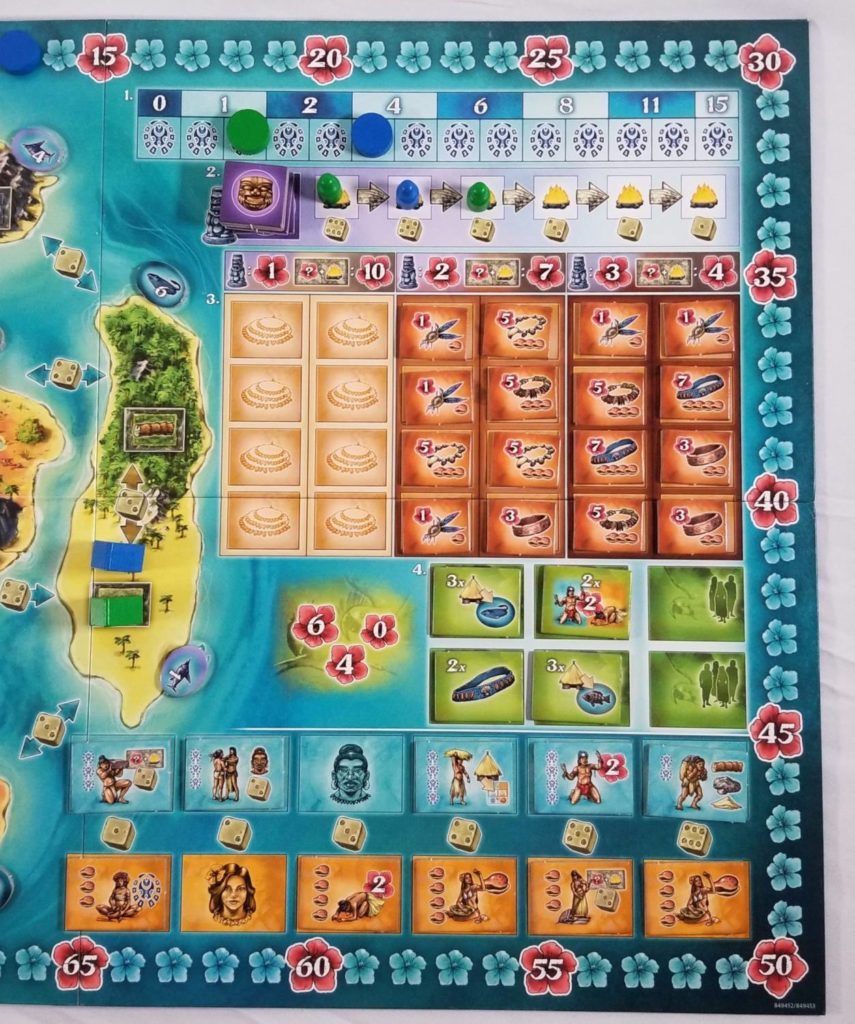
Purchasing Jewelry: Beginning with player 1, each player may purchase a single Jewelry tile from that turn’s column and place it face down on the jewelry area of their player board. This jewelry is used to complete tasks and it is also worth points at the end of the game. A player would be wise to try and purchase jewelry of some sort at the end of each turn if they can.
Completing Tasks and Acquiring New Ones: Beginning with player 1, each person may complete a single task, assuming they have the requirements to do so. They will earn four to six points depending on whether or not they had to use a God card in order to complete it.
Once all players have completed their tasks, then they will take turns (beginning with player 1) selecting a task from one of the tasks in the tasks area of the game board.
At the end of the turn, all of the unpurchased jewelry tiles for that turn are removed along with all of the unpurchased Men, Women, and task tiles. Then new tiles are dealt out to replace all of these, except for the jewelry tiles. The columns of the jewelry area will always correspond to what turn of the game you are in. Once this has all been completed, the next turn begins at Phase A.
Quick God Summary
Each time that you use a God card, you must also discard an Offerings tile. If you do not have an Offerings tile, then you cannot use a God card. Additionally, you can trade in two of a kind for any other single God card. There are five types of gods: blue, white, red, green, and yellow. Here is a brief description of each god and what it can do:
– Blue (Phase A only): allows you to add a die to an action card that is greater than or equal to the lowest number already there.
– White (Phase A only): allows you to place a die, but declare that it is a 6 (the die face does not change).
– Red (Phase A or Phase B): when expanding, you may use the red god to immediately collect victory points equal to the number on the fish tile.
– Green (Phase B only): double the effect of a Man or Woman you are using (basically, treat a single Man or Woman as if you possessed their twin) OR activate a second Man or Woman type (normally you are restricted to using exactly one Man and exactly one Woman. This allows you to break that rule)
– Yellow (Phase C only): Can be used to replace exactly one of a task tile’s requirements. If a task would require you to be holding two white God cards, for instance, you could discard an Offerings tile and use the yellow God card to reduce the requirements by one which would enable you to complete the task with only one white God card in hand, but this would only net you 4 points.
Scoring
At the end of the game, players earn points from: each unused god tile that they have left over; points from Fish tiles; points from their Jewelry tiles; and bonus points if the players fulfilled the conditions. Each bonus is worth 6 points. The bonus point conditions are:
– 9 tasks completed
– 6 Jewelry tiles purchased
– All 12 ceremony spaces are filled with something
– All 6 Building tiles have been placed
– You have a hut in each of the 12 regions
– All 12 of the spots on the right side of your game board have people on them
Thoughts
Bora Bora was my first introduction to Stefan Feld and, boy was it a doozy.
It was a cold November night just a little over nine years ago. A few months earlier, my wife and I had joined a local game group and met a lot of fine folks with whom we’d become fast friends. Chief amongst those was a guy named Matt. Matt and I, as it turned out, were on the same wavelength when it came to board games. Bora Bora was his newest acquisition and he was excited to get it to the table. Specifically, he was excited to get it to the table with me. No doubt, when he looked at me he was thinking something along the lines of: “Now, here’s a person that will GET it. Here’s a person that will really appreciate the experience that is about to unfold.”
And thus, the game was set before us, and he launched into the teach.
That first teach of the game left my mind reeling. There was certainly a lot to take in! I was still fairly new to modern board games at the time, so Bora Bora was far outside the realm of anything I’d ever experienced up to that point. But despite that, it was surprisingly very easy to learn. In no time at all, we were up and playing.
And here I am, nine years later, nine years wiser, and nine years more seasoned. That initial intimidation I felt has long since faded away. Time has a way of mellowing things out. And there’s a lot to be said for experience, too. These days when I sit down to play Bora Bora, I already have a game plan at the ready. And I’m much faster at adapting when that game plan is inevitably derailed.
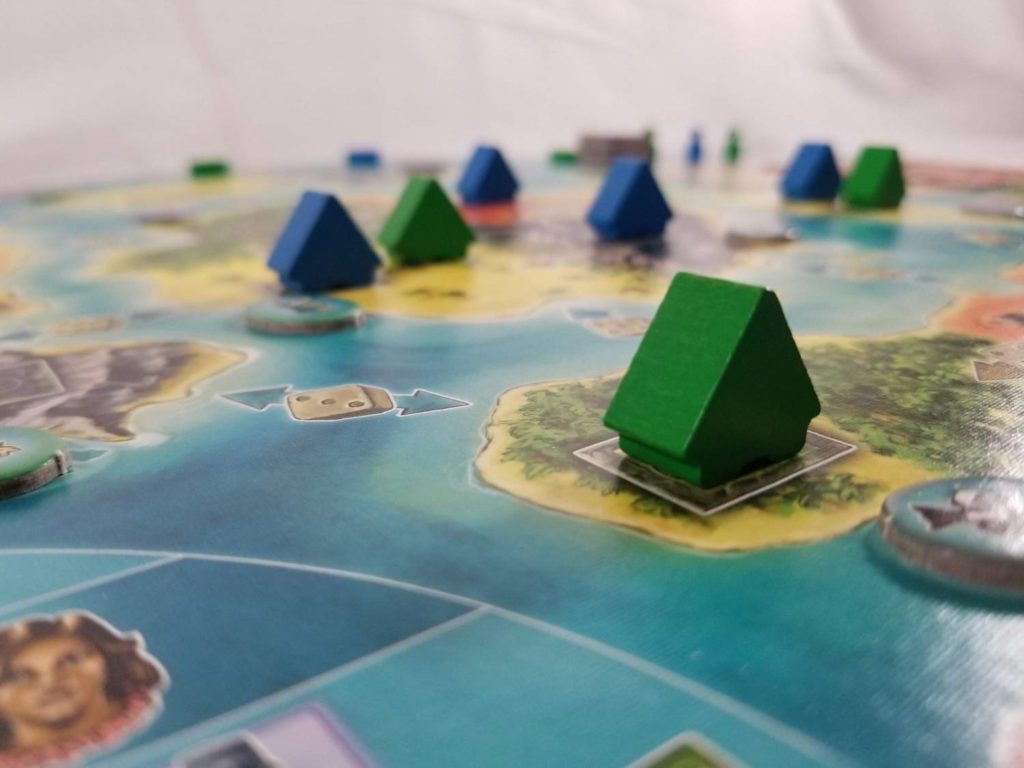
There are some games that will pigeonhole you into playing exactly the same way every game because that one particular mode of play is clearly superior to any other. Bora Bora doesn’t do that. It was clear to me from the very first game I played that there wasn’t just a single, well tread path to victory, but many that were waiting to be discovered.
Initially, I was afraid that the dice would present an insurmountable luck factor. However, my experiences with Bora Bora over the years have shown that, while there is a great deal of randomness involved in this game (dice rolling, card and tile shuffling, etc.), the sheer number of choices and options that you have available to you almost mitigates the luck factor. I love a game that gives me so many options.
Bora Bora’s pretty great when you look at it as a game, but if you start looking too closely at the theme, things begin getting a little more grim.
I already mentioned the gloomy shadow that colonialism casts over everything. And I’m not too sure there’s any way to escape it. People have always been horrible to one another and they’ve done it all over the planet’s surface. Bora Bora seems to hearken back to an older time when the islands were more pure, before the Europeans came along and wreaked their havoc. And this brings me to the more troublesome thematic element, the one I hear someone make a comment about virtually every time this game is played: the subtle scent of sexism.
In Bora Bora, you have your Menfolk who go out and earn all the prestige and you have your Womenfolk who are relegated to collecting shells, and never the twain shall meet. There is no crossover. There are no Women tiles that produce tattoos and there are no Men tiles that produce shells. The fact that the people in the game have been pigeonholed into such a rigid, sexist, hierarchy sets some peoples’ teeth on edge. Whether this was a deliberate choice or just the unfortunate side effect of trying to condense real world activities into the structure of a board game may never be known. But, it’s come up so many times in my plays, that I think it’s worth mentioning.
All negatives aside, though, I really love this game. It has a lot of depth and enough strategy to keep me playing it for a long time to come. I’m glad I added it to my collection. And I’m glad Matt walked in with it that night so long ago. I wasn’t aware of it at the time, but during that first play of Bora Bora, I was taking the first step of a very long, and thoroughly enjoyable, journey. I’m glad you’ve decided to walk some of that journey with me.


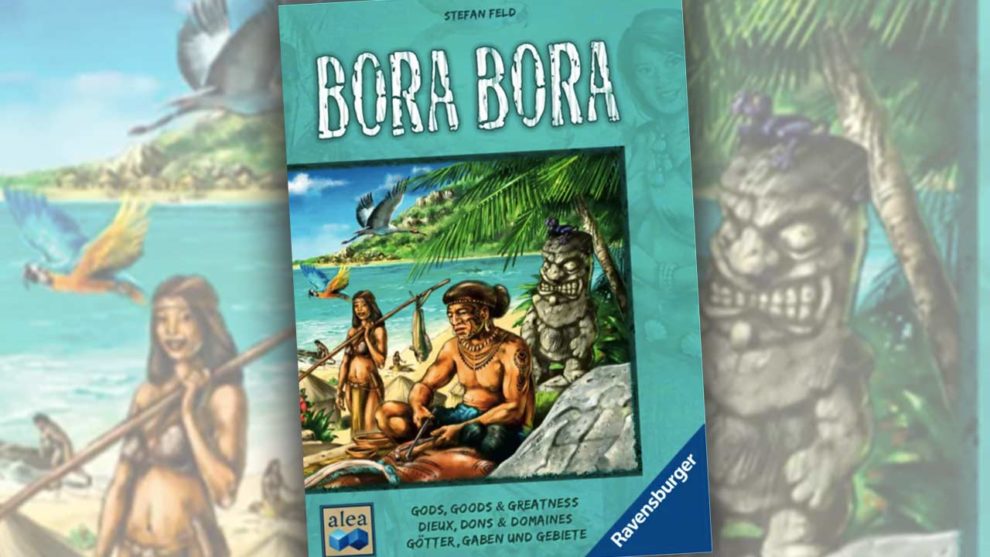



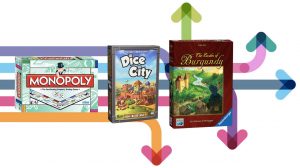




Add Comment